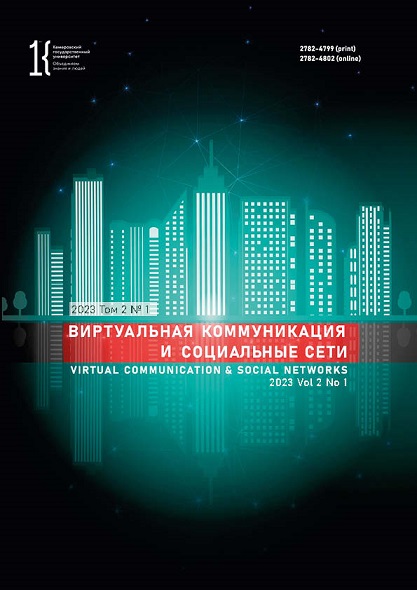Kemerovo, Russian Federation
Kemerovo, Kemerovo, Russian Federation
Advertising is constantly developing as it attempts to keep pace with the ever-changing reality. German producers of cosmetics advertise their brands in German-language online magazines, and these ads often reflect the current changes at the language level. The authors identified and described the current naming methods and patterns in online advertising of German cosmetic brands. The naming strategies followed the rapid global changes and adapted to the constantly emerging new cosmetic products. The most recent nominations proved to be structurally and semantically diverse. Along with the typical German word-formation, they demonstrated some novel methods, which indicated the most recent transformations in the language. The modern German cosmetic advertising is subject to the process of neologization. While each neoplasm adds to the linguistic expressiveness of the language in general, it increases the reader’s involvement in each particular ad. The neologisms were coined in line with German as well as English patterns while some were combinations of them both.
advertising texts, German language, naming methods, neologisms, borrowings, world building
1. Akkuratova I. B. Linguopragmatic potential of words-hybrids in the German language (basing on the notion field "education"). Philology. Theory & Practice, 2018, (7-2): 280–285. (In Russ.) https://doi.org/10.30853/filnauki.2018-7-2.14 EDN: https://elibrary.ru/XSIAOD
2. Burenkova S. V. German neologisms: topics, linguistic features, translation. Review of Omsk State Pedagogical University. Humanitarian research, 2020, (1): 59–63. (In Russ.) https://doi.org/10.36809/2309-9380-2020-26-59-63 EDN: https://elibrary.ru/BRFVFN
3. Vorontsova A. E. Translation transformations of advertising texts of services. Forum molodykh uchenykh, 2018, (6-1): 721–724. (In Russ.) https://elibrary.ru/ymijut
4. Golev N. D. Written communication of modern time: main vectors of development. Tomsk State University Journal of Philology, 2012, (2): 5–17. (In Russ.) https://elibrary.ru/oxvkyh
5. Kulinich E. D., Smirnova A. G. Linguistic, paralinguistic, extralinguistic and cognate means of creating expressiveness in German-language video advertising of cosmetic products. The Journal of Philological Studies, 2023, (1): 21–26. (In Russ.) https://elibrary.ru/typgwy
6. Nakhimova E. A., Pototskaya N. P. Features of localization and translation of precedent phenomena in online advertising discourse (based on the advertising texts of beauty and health products). Aktualnye problemy germanistiki, romanistiki i rusistiki, 2023, (3): 10–13. (In Russ.) https://elibrary.ru/yjannc
7. Nefedova L. A. Foreign language vocabulary of modern German: aspects of cultural integration. Moscow: MPSU, 2018, 184. (In Russ.) https://elibrary.ru/dplhsz
8. Nurgalieva N. Kh. Neologisms and development models of new words in language. Vestnik Bashkirskogo universiteta, 2013, 18(3): 849–857. (In Russ.) https://elibrary.ru/revbfv
9. Petryanina O. V., Revina E. V. Structural-semantic features and cognitive-pragmatic potential of neological names in women’s cosmetics advertising (based on the German language). Philology. Theory & Practice, 2022, 15(6): 1935–1941. (In Russ.) https://doi.org/10.30853/phil20220343 EDN: https://elibrary.ru/KRAJOD
10. Popov P. P. Advertising: the problem of identification and definition. Kazan Science, 2011, (11): 366–368. (In Russ.) https://elibrary.ru/ooalgt
11. Rets I. V. Linguoculturological and ecolinguistic aspects of neonomination. Cand. Philol. Sci. Diss. Abstr. Volgograd, 2014, 24. (In Russ.) https://elibrary.ru/zpjtfv
12. Sinichkina A. P., Smirnova A. G. English borrowings in the virtual German-language advertising communication: Sites of German cosmetics companies. Virtual Communication and Social Networks, 2023, 2(2): 60–65. (In Russ.) https://doi.org/10.21603/2782-4799-2023-2-2-60-65 EDN: https://elibrary.ru/TELDJZ
13. Toroptsev I. S. Word production model. Voronezh: VSU, 1980, 148. (In Russ.)
14. Farzalieva Z. M. Anaphora, epiphora and alliteration in English advertising texts. Actual problems of translation studies and linguodidactics in the context of intercultural interaction: Proc. Intern. Sci.-Prac. Conf., Bryansk, 17–19 Sep 2021. Bryansk: BSU, 2021, 248–252. (In Russ.) https://www.elibrary.ru/sqolyi
15. Fomin A. G., Kim L. G. Linguistic features of virtual communication. Science and Business: Ways of Development, 2019, (2): 191–193. (In Russ.) https://elibrary.ru/yytdcx
16. Chabanyuk T. A. Theory and practice of advertising. Komsomolsk-on-Amur: KnASTU, 2013. 62 p. (In Russ.)
17. Blank A. Why do new meanings occur? A cognitive typology of the motivations for lexical semantic change. Historical semantics and cognition, eds. Blank A., Koch P. Berlin: Mouton de Gruyter, 1999, 61–89. https://doi.org/10.1515/9783110804195.61
18. Faulhaber M., Elsen H. Neologismen in der Kosmetikwerbung. Muttersprache: Vierteljahresschrift für deutsche Sprache, 2016, 3: 193–207. https://doi.org/10.5282/ubm/epub.42292
19. Fleischer W., Schröder M. Wortbildung der deutschen Gegenwartssprache. Berlin/Boston: De Gruyter, 2012, 484. https://doi.org/10.1515/9783110256659
20. Holz L. Untersuchungen zu Neologismen in der Tagespresse: Grundlagen, Erscheinungsformen und Funktionen. Saarbrücken: VDM Verlag Dr. Müller, 2009, 120.















